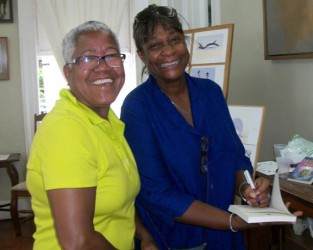Over the years Maureen Marks-Mendonca has decorated her name in a number of fields in the professional world. Writing fiction was not one of them until recent years and it was never her first love.
She was keen with mathematics and loved to tell stories in the schoolyard but when it came to putting something down on paper, she preferred diagrams to words. Of course, once she entered the professional world it was very obvious that it would be impossible to do anything without writing.
As a diplomat, she wrote endless country and regional reports. As a government economist she was tasked with writing weeklies, monthlies and quarterlies for both Guyana and Jamaica, at different times. As a business economist she was required to produce frequent periodicals for international clients – and this was when she finally ‘rediscovered’ her calling. “There was so much competition in my sector that only the most entertaining periodicals got noticed. Mine got noticed,” she said.

Maureen has found that writing requires a lot more footwork than she initially expected. The impression most people have is that the writer writes and the publisher does the rest.
“These days, publishers only like to market celebrity books, or the books of established authors,” she said. “Everyone else is expected to get out there and do their utmost to promote their own books. The inner world of a novelist is a magical place, and many authors would prefer not to be bothered with mundane stuff like getting on the circuit and making their presence felt.”
She revealed that she has three more novels inside her “bubbling”, and ideally she would just like to lock herself away somewhere and get them out of her system, but she also owes it to herself to ensure that her first “child”, Legend of the Swan Children, stays in circulation and that people continue to eagerly await her next work of fiction. “To tell you the truth,” she said, “once I get out there to do readings, book fairs, promotional shows, I get fired up, and I end up loving the interaction between me and my readers, or potential readers.”
Maureen was born in Queenstown, Georgetown in what was then British Guiana, in Elizabeth II’s coronation year. She recalled having British neighbours, seeing horses pulling carriages and nannies walking their charges to the Botanical Gardens in the afternoon sun.
Growing up in Queenstown
Maureen said Queenstown at that time was a wonderfully mixed middle-class community, fairly quiet except for a neighbour’s geese, which would chase any child brave enough to pass that lot.
“Looking at the way Georgetown has grown, it’s probably hard to imagine Queenstown as a suburb of the city proper, but that’s what it was. Georgetown was spotless in those days; a true garden city. As I recall, municipal workers cut the grass on the parapets every week and cleaned the gutters and trenches every month,” she said.
Her “proud parents” were adamant that Maureen and her four siblings would have better opportunities than they themselves had. Music and spirituality were the binding forces that still keep them together even up to this day. Her father, Ulric Marks’ favourite t-shirt carried the slogan, ‘The family that prays together stays together’, to which Maureen was inclined to add, “The family that plays together stays together too.”
Her mother, Stella Marks is deeply religious and so she brought her children up in strict accordance with the “good book.” But in every other way, she encouraged freedom of thought.
The family came from a background of music and so the children were all tasked with learning to play a musical instrument. Maureen said her finely-tuned family kept weekend in-house concerts with their piano, violin, cello, several guitars and a pair of bongo drums. “Marguerite, Michael, Francis, Fay [her siblings], and I had a lot of fun making sweet music.
We played formal classical pieces, Latin music, light jazz, African and Indian music, anything we heard on the radio and liked. I’m sure we drove some of our neighbours slightly crazy, because those were also the days when every window in every house would remain open from morn til night…”
The neighbourhood had a lot of children and the backyards were big; fruit trees abounded – genips, dunks, jamoons, guavas, star apples. The children basically lived in those trees, stuffing themselves with fruit. Simple paling staves separated the yards, so it was easy to slip through a hole in the fence, without parents or nannies or helpers knowing.
“People looked out for each other. Our friends’ parents were ‘aunties’ and ‘uncles’ and had the power to discipline us if we stepped out of line and we didn’t mind, because we all felt like family,” she said.
Not only were relations between neighbours harmonious, but apparently between the animals as well. “When a lot of families were migrating in the mid-60s, I remember a neighbour two doors down left their dog, Gippy, with us,” she related. “They had a cat too but no one in the neighbourhood wanted it, so a friend of the family came to take it away. That cat stayed in hiding for three days until the coast was clear. Then, Gippy went over, found the cat, and in the strangest procession I’d ever seen, walked that cat over to our place, trailed by a pack of curious dogs. They were best friends you see, and had grown used to sleeping together. We kept the cat.”
Legend of the Swan Children
Maureen’s first novel, Legend of the Swan Children revolves around Alejandro Vega Van Sertima, a boy born with mysterious abilities in Alma, a sleepy Spanish village on the Caribbean Sea. Known among the Waspachu by his clan name, Alex Springfeather, he lives a simple but happy life – but this all changes when those around him start to mysteriously disappear, including his mother whom he holds dear.
Alex, in order to solve these mysteries, gets caught up in an adventure through the South American jungles. The people he encounters are either there to kill him or help him and he finds himself in a constant battle with himself.
Magical realism is the genre of writing that Maureen says reflects through Legend of the Swan Children, although some people prefer to say fantasy fiction. “I don’t write about far off lands populated by mythical figures,” she said. “I like to set my scenes in cities and towns that appear quite average, and let the magic unfold in the form of characters that don’t seem to be bound by the same natural laws accepted by society, or events that defy explanation.”
It was Trinidadian literary critic, Debbie Jacob who described Maureen as a ‘magical realist’ in her book review in the November 29, 2009 issue of the Trinidad Guardian newspaper: “This is a magical story set in Guyana that reminds me very much of the magical realism written by the great Guyanese writer Wilson Harris.”
Maureen recalled that her editor Joanne Johnson had asked the question. She said: “I had to admit that I hadn’t read a Wilson Harris novel since my youth. Much later, in my early thirties, I did find myself appreciating another great magical realist – Latin American writer, Gabriel Garcia Marquez. But at that time I was firmly embedded in the world of commerce, hiding the storyteller beneath the folds of facts and figures. I rather think that I was drawn to the genre because… that is who I am.”
Legend of the Swan Children, although targeted at youths, is finding its way into the hearts of people of all ages. Her current work-in-progress, however, will definitely target the adult and young adult markets.
Maureen revealed that the inspiration for her novel came from the disenfranchised youth she worked with in her spare time and the lead character, Alex, came to her in a dream. She revealed that Alex has within him the same hurt, undying spark of innocence, and dogged faith she encountered in the orphans, street kids, and refugees at her workshops over the years.
Legend itself was actually written twice: once for a very special teenage friend who had lost her way, and the second time to satisfy the commercial needs of the publisher, who required her to “lose 12,000 words”.
“I’d like to think that I’ll continue to grow, as a writer, both in style and content, so that when I pen my last book, I’ll be able to sit back in satisfaction and say, this one is pure beauty. No publisher would want to change a single word or phrase.
“I think after I give birth to the last of the three ‘children’ currently in gestation, that is, the three novels I spoke of earlier … I’d like to focus on short stories. The book I’m currently working on is in fact… twelve short stories about love. There is something very appealing about saying all you have to say in twenty pages or less. There is a Zen part of me that yearns to show its pithy face.”
When she is not working, she spends quality time with her friends and family. She is happily married to a man she describes as wonderful and respectful enough to let her be herself. Apart from writing, she satisfies her creative urges by playing the classical guitar.





